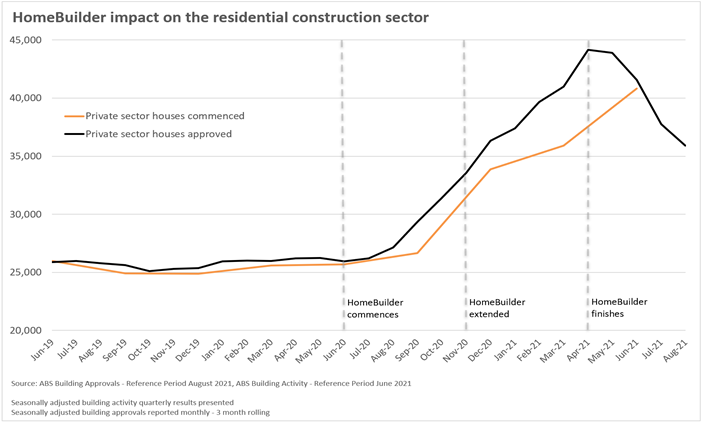Since the introduction of HomeBuilder in June 2020, the construction sector has been racing the clock, trying to keep up with unprecedented demand. However, it isn’t easy to build houses faster when it can take 30 years for a tree to grow large enough for it to produce structural grade timber. Tim Stafford, head of research at WBP Group, investigates how much further this race has to run.
When it became apparent the Covid pandemic would play havoc with the construction sector, a vital cog in the Australian economy, the federal government stepped in with a new grant to stabilise things and keep the sector running.
The government initially planned for the Homebuilder grant to run for five months, from June 2020 until November 2020. However, it proved too tempting to resist for those looking to build a new home. So, on the back of a dramatic spike in demand, the government chose to extend the grant until April 2021.
Historically, the metrics used to measure housing commencements and approvals have always been relatively close. But since the introduction of Homebuilder, a significant gap has opened up. Figures from the Australian Bureau of Statistics (ABS) show in the three months to April 2021, housing approvals peaked at nearly 45,000. While at the same time, commencements were almost 10,000 lower.
While the latest ABS figures show house commencements trending in the right direction, the numbers are still not high enough. And, they are not climbing at a fast enough rate to match the peak in housing approvals. The construction sector needs to ‘dig in,’ because looking at the numbers, they still need to build many more houses to keep up with the demand.
With over 10,000 hectares of pine plantations and operations across Victoria, New South Wales, and Queensland, AKD Softwoods is Australia’s largest producer of structural timber. When the pandemic first hit, they forecast a 30% to 50% drop in sales. But that reduction never eventuated. Instead, the company increased sales by more than 20% year on year and increased structural timber production by 12%.
Even with the increased production, AKD has been unable to satisfy demand. Liam Buchanan, General Manager Sales at AKD, explained, “our account managers are constantly under stress from anxious customers, both new and existing, and are constantly fielding calls from people the whole way along the supply chain chasing structural timber.”
Nationwide, “timber producers are spending capital on increasing production and innovating trying to get more structural timber out of what they currently cut.” Mr Buchanan said. And while AKD has additional capacity in their Tumut (south-eastern NSW) sawmill, they have been restricted by log availability after the Black Summer bushfires burnt up to 40% of the available sawlog in this region.
Australian timber producers have never been able to supply the entire domestic market, so suppliers have relied on imports to fill the void. Mr Buchanan estimates this void to be anywhere from 20% to 30%, depending on demand. “The market is beholden to imports, and currently, global shipping costs and availability is restricting supply,” he said.
While timber producers have been working to increase the supply of structural timber, the building industry has also been in a mad dash to increase output. The latest Building Activity Data from the ABS showed a substantial increase in housing commencements over the June quarter, with a rise of almost 14% from the previous quarter. However, this number is still well below where it needs to be for builders to be keeping pace with demand.
I’m sure the construction sector took a collective sigh of relief upon hearing that the federal government would end Homebuilder in April 2021. A smile might have even come to their faces when they saw housing approval numbers trending back towards more normal levels. However, this trend has been short-lived. Housing approvals have been steady over the last three months, hovering around 12,000 per month.
It’s now six months since the end of Homebuilder, and demand is still strong. Even without the incentive of a grant, housing approvals are approximately 24% above the long-term average.
Mr Buchanan does not see a quick fix and expects the market will be tight for some time. “Based on approval data and information collected from our frame and truss customers, there is a strong pipeline (demand) for timber for the foreseeable future. Some of the larger project builders have told us that even without selling another home in 2021, they have more than enough work on their books to be building homes well into 2023.”
Endurance runners often talk about ‘hitting the wall’. It’s the point at where the runner has depleted their energy levels so significantly that they begin to suffer fatigue. The worst place for this to happen is just before you reach the peak. I wonder, is the construction sector about to feel this pain, or can they continue to find new ways to increase output even further?
Author Tim Stafford is Senior Valuer and Head of Research at WBP Group. For the last 18 years, he has specialised in the mortgage valuation sector.
If you’re interested in improving the quality of service you extend to your clients, follow WBP Group on LinkedIn to get more helpful valuation insights.










